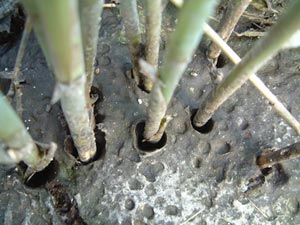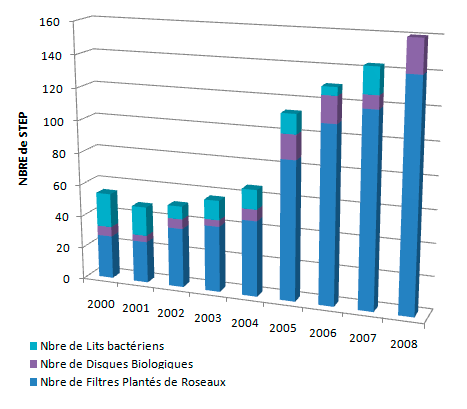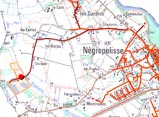The constructed wetland
The CW system
 Constructed wetland system is a recent sanitation technology based on the optimisation of natural processes.
Constructed wetland system is a recent sanitation technology based on the optimisation of natural processes.
Principle: Suspended Solids-SS are retained on the filter surface and the organic content of the wastewater is mineralised in passing through the filter by bacteria fixed on the gravel and reed rhizomes or roots.
Appeared at the very end of the twentieth century, little before the European deadlines on wastewater treatment, the CW technology spread very fast, especially in the range of 2 000 PE and less: in France, it went from ten plants in 2000 to several hundreds in 2004 and two thousand in 2010.
Two main applications in France currently:
- treatment of domestic wastewater on Vertical Flow Constructed Wetlands-VFCW
- treatment of domestic septage on Vertical Flow Constructed Wetlands-VFCW.
The principle is identical and the implementation notably different for these two applications.
Chronogram of the openings of new wastewater plants in France.
Sources: BDERU, Ministry of Environment

Wastewater Treatment
The setup
The setup
Constructed Wetlands changed significantly the wastewater treatment picture in its range i.e. from 10 to 10 000 PE, in France and worldwide. The design adopted in Nègrepelisse, as almost everywhere in France at the instigation of Cemagref *, includes two successive stages of Vertical Flow Constructed Wetlands.
The raw wastewater is spread at the surface of the primary filter and collected at the bottom by a system of drainage pipes. It passes successively through a layer of fine gravel, a transition layer of mean gravel and a bottom layer of coarse gravel.
The secondary filter operates on the same principle, with finer aggregates and a slightly different system of water distribution on the filter surface.
The sludge treatment
Vertical Flow Constructed Wetlands are also used for drying and treating the liquid sludge produced by intensive treatment plants (Activated Sludge process for example) with coarser aggregates, higher organic loads, higher concentrations in the effluent. The deposits on the filter surface are thicker (up to 1.50 m against 0.20 to 0.30 m for wastewater filters) and taken away at closer intervals (less than five years against ten to fifteen years for wastewater filters). In other words, the sludge filter is the compact or intensive version of the wastewater filter: higher loads per square meter of filter and an increased technical complexity.
This sludge configuration is also used for the treatment of septage, notably on the MV82 unit of Nègrepelisse, and for the treatment of latrine sludge in the poor countries.

The facts
This page sums up the wastewaters treatment plant’s main characteristics.
Read the dossier
